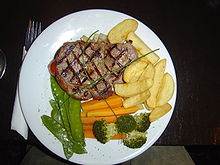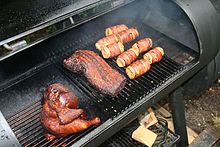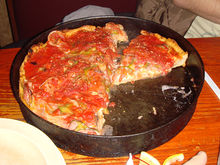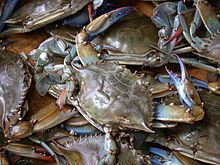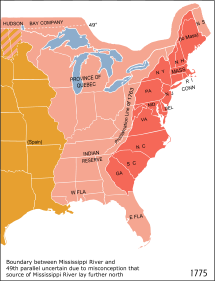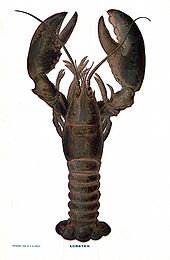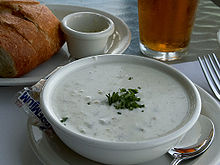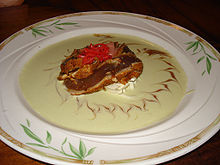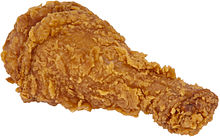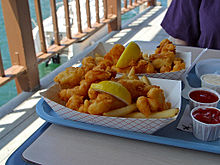- American cuisine
-
For other uses, see American cuisine (disambiguation).
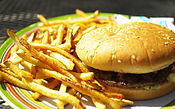
This article is part of the series on American cuisine Regional cuisinesNortheastern
New England • New Jersey • New York City • Philadelphia • Pennsylvania Dutch
Midwestern
Chicago • North Dakota • OmahaSouthern (list)
Cajun • Floribbean • Kentucky • Louisiana Creole • Lowcountry • Soul food (list)Western
California • California fusion • Pacific Northwest • Rocky MountainSouthwestern
New Mexican • Tex-MexOther
Hawaiian (regional) • Military rations • Puerto Rican • RoadkillStylesBarbecue (Texas, other regional) • Fast food • Fusion • New American
Religious and ethnicImmigrant • American Chinese • Christmas • Euro-Asian • Halal • Italian-American • Jewish • Native American
Rituals & FestivalsChristmas • Thanksgiving
 United States portalA sirloin steak dinner, served with sauteed onion, wedged potatoes, broccoli, carrots, and snow peas and garnished with chives
United States portalA sirloin steak dinner, served with sauteed onion, wedged potatoes, broccoli, carrots, and snow peas and garnished with chives
Culture of the
United StatesArchitecture
Art
Cinema
Comic books
Cuisine
Dance
Folklore
Literature
Music
Poetry
Radio
Sculpture
Sports
Television
TheaterAmerican cuisine is a style of food preparation originating from the United States of America. European colonization of the Americas yielded the introduction of a number of ingredients and cooking styles to the latter. The various styles continued expanding well in to the 19th and 20th centuries, proportional to the influx of immigrants from many foreign nations; such influx developed a rich diversity in food preparation throughout the country.
Contents
History
Seafood
Saltwater fish eaten by the American Indians were cod, lemon sole, flounder, herring, halibut, sturgeon, smelt, drum on the East Coast, and olachen and salmon on the West Coast. Whale was hunted by American Indians off the Northwest coast, especially by the Makah, and used for their meat and oil.[1] Seal and walrus were also utilized. Eel from New York's Finger Lakes region were eaten. Catfish seemed to be favored by tribes, including the Modocs. Crustacean included shrimp, lobster, crayfish, and dungeness crabs in the Northwest and blue crabs in the East. Other shellfish include abalone and geoduck on the California coast, while on the East Coast the surf clam, quahog, and the soft-shell clam. Oysters were eaten on both shores, as were mussels and periwinkles.[2]
Cooking methods
Early Native Americans utilized a number of cooking methods in early American Cuisine, that have been blended with early European cooking methods to form the basis of American Cuisine. Grilling meats was common. Spit roasting over a pit fire was common as well. Vegetables, especially root vegetables were often cooked directly in the ashes of the fire. As early American Indians lacked the proper pottery that could be used directly over a fire, they developed a technique which has caused many anthropologists to call them "Stone Boilers". They would heat rocks directly in a fire and then add the bricks to a pot filled with water until it came to a boil so that it would cook the meat or vegetables in the boiling water. In what is now the Southwestern United States, they also created ovens made of adobe called hornos in which to bake items such as breads made from cornmeal and in other parts of America, made ovens out of dug pits. These pits were also used to steam foods by adding heated rocks or embers and then seaweed or corn husks (or other coverings) placed on top to steam fish and shellfish as well as vegetables; potatoes would be added while still in-skin and corn while in-husk, this would later be referred to as a clambake by the colonists.[3]
Colonial period
When the colonists came to America, their initial attempts at survival included planting crops familiar to them from back home in England. In the same way, they farmed animals for clothing and meat in a similar fashion. Through hardships and eventual establishment of trade with Britain, the West Indies and otvvfgh fgay regions, the colonists were able to establish themselves in the American colonies with a cuisine similar to their previous British cuisine. There were some exceptions to the diet, such as local vegetation and animals, but the colonists attempted to use these items in the same fashion as they had their equivalents or ignore them if they could. The manner of cooking for the American colonists followed along the line of British cookery up until the Revolution. The British sentiment followed in the cookbooks brought to the New World as well.[4]
There was a general disdain for French cookery, even with the French Huguenots in South Carolina and French-Canadians. One of the cookbooks that proliferated in the colonies was The Art of Cookery Made Plain and Easy written by Hannah Glasse, wrote of disdain for the French style of cookery, stating “the blind folly of this age that would rather be imposed on by a French booby, than give encouragement to a good English cook!” Of the French recipes, she does add to the text she speaks out flagrantly against the dishes as she “… think it an odd jumble of trash.”[5] Reinforcing the anti-French sentiment was the French and Indian War from 1754-1764. This created a large anxiety against the French, which influenced the English to either deport many of the French, or as in the case of the Acadians, they migrated to Louisiana. The Acadian French did create a large French influence in the diet of those settled in Louisiana, but had little or no influence outside of Louisiana.[6]
Common ingredients
The American colonial diet varied depending on the settled region in which someone lived. Local cuisine patterns had established by the mid 18th century. The New England colonies were extremely similar in their dietary habits to those that many of them had brought from England. A striking difference for the colonists in New England compared to other regions was seasonality.[7] While in the southern colonies, they could farm almost year round, in the northern colonies, the growing seasons were very restricted. In addition, colonists’ close proximity to the ocean gave them a bounty of fresh fish to add to their diet, especially in the northern colonies. Wheat, however, the grain used to bake bread back in England was almost impossible to grow, and imports of wheat were far from cost productive.[8] Substitutes in cases such as this included cornmeal. The Johnnycake was a poor substitute to some for wheaten bread, but acceptance by both the northern and southern colonies seems evident.[9]
As many of the New Englanders were originally from England game hunting was often a pastime from back home that paid off when they immigrated to the New World. Much of the northern colonists depended upon the ability either of themselves to hunt, or for others from which they could purchase game. This was the preferred method for protein consumption over animal husbandry, as it required much more work to defend the kept animals against American Indians or the French.
Livestock and game
Commonly hunted and eaten game included deer, bear, buffalo and wild turkey. The larger muscles of the animals were roasted and served with currant sauce, while the other smaller portions went into soups, stews, sausages, pies, and pasties.[10] In addition to game, colonists' protein intake was supplemented by mutton. The Spanish in Florida originally introduced sheep to the New World, but this development never quite reached the North, and there they were introduced by the Dutch and English. The keeping of sheep was a result of the English non-practice of animal husbandry.[11] The animals provided wool when young and mutton upon maturity after wool production was no longer desirable.[12] The forage-based diet for sheep that prevailed in the Colonies produced a characteristically strong, gamy flavor and a tougher consistency, which required aging and slow cooking to tenderize.[13]
Fats and oils
A number of fats and oils made from animals served to cook much of the colonial foods. Many homes had a sack made of deerskin filled with bear oil for cooking, while solidified bear fat resembled shortening. Rendered pork fat made the most popular cooking medium, especially from the cooking of bacon. Pork fat was used more often in the southern colonies than the northern colonies as the Spanish introduced pigs earlier to the South. The colonists enjoyed butter in cooking as well, but it was rare prior to the American Revolution, as cattle were not yet plentiful.[14]
Seafood
Those living near the New England shore often dined on fish, crustaceans, and other animals that originated in the waters. Colonists ate large quantities of turtle, and it was an exportable delicacy for Europe. Cod, in both fresh and salted form was enjoyed, with the salted variation created for long storage. The highest quality cod was usually dried, however, and exported to the Mediterranean in exchange for fruits not available in the American colonies.[15] Lobsters proliferated in the waters as well, and were extremely common in the New England diet.
Alcoholic drinks
Prior to the Revolution, New Englanders consumed large quantities of rum and beer, as maritime trade provided them relatively easy access to the goods needed to produce these items: Rum was the distilled spirit of choice, as the main ingredient, molasses, was readily available from trade with the West Indies. Further into the interior, however, one would often find colonists consuming whiskey, as they did not have similar access to sugar cane. They did have ready access to corn and rye, which they used to produce their whiskey.[16] However, until the Revolution, many considered whiskey to be a coarse alcohol unfit for human consumption, as many believed that it caused the poor to become raucous and unkempt drunkards.[17] Yet one item, hops, important for the production of beer, did not grow well in the colonies. Hops only grew wild in the Old World, and as such, importation from England and elsewhere became essential to beer production. In addition to these alcohol-based products produced in America, imports were seen on merchant shelves, including wine and brandy.[18]
Southern variations
In comparison to the northern colonies, the southern colonies were quite diverse in their agricultural diet and did not have a central region of culture. The uplands and the lowlands made up the two main parts of the southern colonies. The slaves and poor of the south often ate a similar diet, which consisted of many of the indigenous New World crops. Salted or smoked pork often supplement the vegetable diet. Rural poor often ate squirrel, possum, rabbit and other woodland animals. Those on the “rice coast” often ate ample amounts of rice, while the grain for the rest of the southern poor and slaves was cornmeal used in breads and porridges. Wheat was not an option for most of those that lived in the southern colonies.[19]
The diet of the uplands often included cabbage, string beans, white potatoes, while most avoided sweet potatoes and peanuts. Non-poor whites in the uplands avoided crops imported from Africa because of the perceived inferiority of crops of the African slaves. Those who could grow or afford wheat often had biscuits as part of their breakfast, along with healthy portions of pork. Salted pork was a staple of any meal, as it was used in the preparations of vegetables for flavor, in addition to its direct consumption as a protein.[20]
The lowlands, which included much of the Acadian French regions of Louisiana and the surrounding area, included a varied diet heavily influenced by Africans and Caribbeans, rather than just the French. As such, rice played a large part of the diet as it played a large part of the diets of the Africans and Caribbean. In addition, unlike the uplands, the lowlands subsistence of protein came mostly from coastal seafood and game meats. Much of the diet involved the use of peppers, as it still does today.[21] Interestingly, although the English had an inherent disdain for French foodways, as well as many of the native foodstuff of the colonies, the French had no such disdain for the indigenous foodstuffs. In fact, they had a vast appreciation for the native ingredients and dishes.[22]
20th century—21st century
Some corporate kitchens (for example, General Mills, Campbell's, Kraft Foods) develop consumer recipes. One characteristic of American cooking is the fusion of multiple ethnic or regional approaches into completely new cooking styles. Asian cooking has played a particularly large role in American fusion cuisine.[23]
Similarly, while some dishes considered typically American many have their origins in other countries, American cooks and chefs have substantially altered them over the years, to the degree that the dishes now enjoyed the world over are considered to be American. Hot dogs and hamburgers are both based on traditional German dishes, brought over to America by German immigrants to the United States, but in their modern popular form they can be reasonably considered American dishes.[24]
Many companies in the American food industry develop new products requiring minimal preparation, such as frozen entrees.[25] Many of these recipes have become very popular. For example, the General Mills Betty Crocker's Cookbook, first published in 1950 and currently in its 10th edition,[26] is commonly found in American homes.[27]
Regional cuisine
- Main article List of American regional and fusion cuisines
Given the United States' large size it has numerous regional variations. The United States' regional cuisine is characterized by its extreme diversity and style with each region having its own distinctive cuisine.
New England
- Main article Cuisine of New England
New England is a northeastern region of the United States, including the six states of Connecticut, Maine, Massachusetts, New Hampshire, Rhode Island, and Vermont. The American Indians cuisine became part of the cookery style that the early colonists brought with them.[citation needed] The style of New England cookery originated from its colonial roots, that is to say practical, frugal and willing to eat anything other than what they were used to from their British roots.[28] Much of the cuisine started with one-pot cookery, which resulted in such dishes as succotash, chowder, baked beans, and others.[29]
Lobster is an integral ingredient to the cuisine, indigenous to the shores of the region. Other shellfish of the coastal regions include little neck clams, sea scallops, blue mussels, oysters, soft shell clams and razor shell clams. Much of this shellfish contributes to New England tradition, the clambake. The clambake as known today is a colonial interpretation of an American Indian tradition.[30]
The fruits of the region include the Vitis labrusca grapes used in grape juice made by companies such as Welch's, along with jelly, Kosher wine by companies like Mogen David and Manischewitz along with other wineries that make higher quality wines. Apples from New England include the original varieties, Baldwin, Lady, Mother, Pomme Grise, Porter, Roxbury Russet, Wright, Sops of Wine, Peck's Pleasant, Titus Pippin, Westfield-Seek-No-Further, and Duchess of Oldenburg. Cranberries are another fruit indigenous to the region.[31]
Pacific & Hawaiian Cuisine
Hawaiian regional cuisine covers everything from wok-charred ahi tuna, opakapaka (snapper) with passionfruit, to Hawaiian island-raised lamb, beef and aquaculture products such as Molokai shrimp. Includes a broad variety of produce - most notably tomatoes, strawberries, mushrooms, sweet maui onions and tropical fruits such as papayas, mangoes, lilikoi (passionfruit) and lychee.
Midwest
- Main article Cuisine of the Midwestern United States
Midwestern cuisine covers everything from barbecue to the Chicago-style hot dog.
The American South
The cuisine of the American South has been influenced by the many diverse inhabitants of the region, including Americans of European descent, Native Americans and African Americans.
Cuisine in the West
- Main article Cuisine of the Western United States
Cooking in the American West includes the fast food hamburger and the San Francisco burrito.
American Southwestern Cuisine
- Main article Cuisine of the Southwestern United States
Southwestern food draws influences from Mexican cooking including tex-mex and the burrito.
Common dishes found on a regional level
Ethnic and immigrant influence
The demand for ethnic foods in the United States reflects the nation's changing diversity as well as its development over time. According to the National Restaurant Association,
Restaurant industry sales are expected to reach a record high of $476 billion in 2005, an increase of 4.9 percent over 2004... Driven by consumer demand, the ethnic food market reached record sales in 2002, and has emerged as the fastest growing category in the food and beverage product sector, according to USBX Advisory Services. Minorities in the U.S. spend a combined $142 billion on food and by 2010, America's ethnic population is expected to grow by 40 percent.[32]
A movement began during the 1980s among popular leading chefs to reclaim America's ethnic foods within its regional traditions, where these trends originated. One of the earliest was Paul Prudhomme, who in 1984 began the introduction of his influential cookbook, Paul Prodhomme's Louisiana Kitchen, by describing the over 200 year history of Creole and Cajun cooking; he aims to "preserve and expand the Louisiana tradition."[33] Prodhomme's success quickly inspired other chefs. Norman Van Aken embraced a Floridian type cuisine fused with many ethnic and globalized elements in his Feast of Sunlight cookbook in 1988. The movement finally gained fame around the world when California became swept up in the movement, then seemingly started to lead the trend itself, in, for example, the popular restaurant Chez Panisse in Berkeley. Examples of the Chez Panisse phenomenon, chefs who embraced a new globalized cuisine, were celebrity chefs like Jeremiah Tower and Wolfgang Puck, both former colleagues at the restaurant. Puck went on to describe his belief in contemporary, new style American cuisine in the introduction to The Wolfgang Puck Cookbook:
Another major breakthrough, whose originators were once thought to be crazy, is the mixing of ethnic cuisines. It is not at all uncommon to find raw fish listed next to tortillas on the same menu. Ethnic crossovers also occur when distinct elements meet in a single recipe. This country is, after all, a huge melting pot. Why should its cooking not illustrate the American transformation of diversity into unity?[34]
Puck's former colleague, Jeremiah Tower became synonymous with California Cuisine and the overall American culinary revolution. Meanwhile, the restaurant that inspired both Puck and Tower became a distinguished establishment, popularizing its so called "mantra" in its book by Paul Bertolli and owner Alice Waters, Chez Panisse Cooking, in 1988. Published well after the restaurants' founding in 1971, this new cookbook from the restaurant seemed to perfect the idea and philosophy that had developed over the years. The book embraced America's natural bounty, specifically that of California, while containing recipes that reflected Bertoli and Waters' appreciation of both northern Italian and French style foods.
Early ethnic influences
While the earliest cuisine of the United States was influenced by indigenous American Indians, the cuisine of the thirteen colonies or the culture of the antebellum American South; the overall culture of the nation, its gastronomy and the growing culinary arts became ever more influenced by its changing ethnic mix and immigrant patterns from the 18th and 19th centuries unto the present. Some of the ethnic groups that continued to influence the cuisine were here in prior years; while others arrived more numerously during “The Great Transatlantic Migration (of 1870—1914) or other mass migrations.
Some of the ethnic influences could be found in the nation from after the American Civil War and into the History of United States continental expansion during most of the 19th century. Ethnic influences already in the nation at that time would include the following groups and their respective cuisines:
- Select nationalities of Europe and the respective developments from early modern European cuisine of the colonial age:
- British-Americans and on-going developments in New England cuisine, the national traditions founded in cuisine of the thirteen colonies and some aspects of other regional cuisine.
- Spanish Americans and early modern Spanish cuisine, as well as Basque-Americans and Basque cuisine.
- Early German-American or Pennsylvania Dutch and Pennsylvania Dutch cuisine
- French Americans and their "New World" regional identities such as:
- Acadian
- Cajun and Cajun cuisine
- Louisiana Creole and Louisiana Creole cuisine. Louisiana Creole (also called French Créole) refers to native born people of the New Orleans area who are descended from the Colonial French and/or Spanish settlers of Colonial French Louisiana, before it became part of the United States in 1803 with the Louisiana Purchase.
- The various ethnicities originating from early social factors of Race in the United States and the gastronomy and cuisines of the “New World,” Latin American cuisine and North American cuisine:
- Indigenous American Indians in the United States (Indians) and American Indian cuisine
- African-Americans and “Soul food.”
- Cuisine of Puerto Rico
- Mexican-Americans and Mexican-American cuisine; as well as related regional cuisines:
- Tex-Mex (regional Texas and Mexican fusion)
- Cal-Mex (regional California and Mexican fusion)
- Some aspects of “Southwestern cuisine.”
- Cuisine of New Mexico
Later ethnic and immigrant influence
Mass migrations of immigrants to the United States came in several waves. Historians identify several waves of migration to the United States: one from 1815–1860, in which some five million English, Irish, Germanic, Scandinavian, and others from northwestern Europe came to the United States; one from 1865–1890, in which some 10 million immigrants, also mainly from northwestern Europe, settled, and a third from 1890–1914, in which 15 million immigrants, mainly from central, eastern, and southern Europe (many Austrian, Hungarian, Turkish, Lithuanian, Russian, Jewish, Greek, Italian, and Romanian) settled in the United States. [2]
Together with earlier arrivals to the United States (including the indigenous American Indians, Hispanic and Latino Americans, particularly in the West, Southwest, and Texas; African Americans who came to the United States in the Atlantic slave trade; and early colonial migrants from Britain, France, Germany, and elsewhere, these new waves of immigrants had a pro profound impact on national or regional cuisine. Some of these more prominent groups include the following:
- Irish Americans - Irish cuisine
- Italian Americans - Italian-American cuisine
- German Americans - German cuisine (the Pennsylvania Dutch, although descended from Germans, arrived early than the bulk of German migrants and have distinct culinary traditions)
- Scottish Americans - Scottish cuisine
- Greek Americans - Greek cuisine, Mediterranean cuisine
- Portuguese Americans - Portuguese cuisine
- Polish Americans - Polish cuisine, with particular impact on Midwest
- Russian Americans - Russian cuisine, with particular impact on Midwest
- Lithuanian Americans - Lithuanian cuisine, with particular impact on Midwest
- American Jews - Jewish cuisine
- Indian Americans - Indian cuisine
- Japanese Americans - Japanese cuisine and influences on the Hawaiian cuisine
- Polynesian Americans - Hawaiian cuisine
- West Indian Americans - Caribbean cuisine, Jamaican cuisine
- Cuban Americans - Cuban cuisine
- Chinese Americans - American Chinese cuisine,Chinese cuisine
- Vietnamese Americans - Vietnamese cuisine
- Arab Americans, particularly Lebanese Americans (the largest ethnic Arab group in the United States) - Arab cuisine, Lebanese cuisine
"Italian, Mexican and Chinese (Cantonese) cuisines have indeed joined the mainstream. These three cuisines have become so ingrained in the American culture that they are no longer foreign to the American palate. According to the study, more than nine out of 10 consumers are familiar with and have tried these foods, and about half report eating them frequently. The research also indicates that Italian, Mexican and Chinese (Cantonese) have become so adapted to such an extent that "authenticity" is no longer a concern to customers."[35]
Contributions from these ethnic foods have become as common as traditional "American" fares such as hot dogs, hamburgers, beef steak, which are derived from German cuisine, (chicken-fried steak, for example, is a variation on German schnitzel), cherry pie, Coca-Cola, milkshakes, fried chicken (Fried chicken is of Scottish and African influence) and so on. Nowadays, Americans also have a ubiquitous consumption of foods like pizza and pasta, tacos and burritos to "General Tso's chicken" and fortune cookies. Fascination with these and other ethnic foods may also vary with region.
Notable American chefs
American chefs have been influential both in the food industry and in popular culture. An important 19th Century American chef was Charles Ranhofer of Delmonico's Restaurant in New York City. American cooking has been exported around the world, both through the global expansion of restaurant chains such as T.G.I. Friday's and McDonald's and the efforts of individual restaurateurs such as Bob Payton, credited with bringing American-style pizza to the UK.[36]
The first generation of television chefs such as Robert Carrier and Julia Child tended to concentrate on cooking based primarily on European, especially French and Italian, cuisines. Only during the 1970s and 1980s did television chefs such as James Beard and Jeff Smith shift the focus towards home-grown cooking styles, particularly those of the different ethnic groups within the nation. Notable American restaurant chefs include Thomas Keller, Charlie Trotter, Grant Achatz, Alfred Portale, Paul Prudhomme, Paul Bertolli, Alice Waters, and celebrity chefs like Mario Batali, Alton Brown, Emeril Lagasse, Cat Cora, Michael Symon, Bobby Flay, Ina Garten, Todd English, and Paula Deen.
Regional chefs are emerging as localized celebrity chefs with growing broader appeal, such as Peter Merriman (Hawaii Regional Cuisine), Jerry Traunfeld, Alan Wong (Pacific Rim cuisine), Norman Van Aken (New World Cuisine - fusion Latin, Caribbean, Asian, African and American), and Mark Miller (American Southwest cuisine).
See also
- List of American regional and fusion cuisines
- Native American cuisine
- Tlingit cuisine
Notes
- ^ A Fact Sheet Issued by the Makah Whaling Commission
- ^ Root & De Rochemont 1981:21,22
- ^ Root & De Rochemont 1981:31,32
- ^ Smith 2004:512.
- ^ Glasse 1750.
- ^ Smith 2004:512, Vol. 1.
- ^ Oliver 2005:16–19.
- ^ Pillsbury 1998:25.
- ^ Oliver 2005:22.
- ^ Smith 2004:546–547, Vol. 1.
- ^ Smith 2004:26, Vol. 2.
- ^ Root & De Rochemont 1981:176–182
- ^ Apple Jr., R.W. (2006-03-29). "Much Ado About Mutton, but Not in These Parts". New York Times. http://www.nytimes.com/2006/03/29/dining/29mutt.html. Retrieved 2008-01-23. "Until it fell from favor after World War II, it was a favorite of most Britons, who prized mutton (defined there as the meat from sheep at least 2 years old) above lamb (from younger animals) for its texture and flavor. It has a bolder taste, a deeper color and a chewier consistency."
- ^ Smith 2004:458–459, Vol. 2.
- ^ Root & De Rochemont 1981:82–85
- ^ Pillsbury 1998:17.
- ^ Crowgey 1971:18–19.
- ^ Pillsbury 1998:18.
- ^ Pillsbury 1998:34–35.
- ^ Pillsbury 1998:47–48.
- ^ Pillsbury 1998:48–49.
- ^ Smith 2004:149, Vol. 2.
- ^ Asian Cuisine & Foods
- ^ Hamburgers & Hot Dogs - All-American Food
- ^ ConAgra’s Chief Is Moving to Revitalizny's products
- ^ Crocker 2005.
- ^ Face value: Fictional Betty Crocker gives big business a human touch
- ^ Smith 2004:181–182.
- ^ Danforth, Feierabend & Chassman 1998:13
- ^ Danforth, Feierabend & Chassman 1998:12–19
- ^ Danforth, Feierabend & Chassman 1998:24–26
- ^ Oralia 2005 (par. 6).
- ^ Prodhomme 1984 n.p.
- ^ Puck 1986 n.p.
- ^ Hensley, Sue, National Restaurant Association. Article/ News Release, "International Cuisine Reaches America's Main Street," 10 August 2000.
- ^ Bob Payton, 50, Restaurateur, Dies. New York Times July 16, 1994, Obituary, p 28.[1]
Works cited
- Basso, Keith H. (1983). "Western Apache". In Ortiz, A.. Handbook of North American Indians: Southwest. 10. Washington, D.C.: Smithsonian Institution. pp. 462–488..
- Bertolli, Paul; Alice Waters (1988). Chez Panisse Cooking. New York: Random House..
- Crocker, Betty (2005). Betty Crocker Cookbook: Everything You Need to Know to Cook Today (10, illustrated, revised ed.). John Wiley & Sons, Incorporated. ISBN 9780764568770..
- Crowgey, Henry G. (1971). Kentucky Bourbon: The Early Years of Whiskeymaking'. Kentucky: The University Press of Kentucky..
- Danforth, Randi; Feierabend, Peter.; Chassman, Gary. (1998). Culinaria The United States: A Culinary Discovery. New York: Konemann..
- Foster, Morris W; McCollough, Martha (2001). "Western Apache". In DeMallie, R. J.. Handbook of North American Indians: Plains. 13. Washington, D.C.: Smithsonian Institution. pp. 926–939..
- Glasse, Hannah (1750). Art of Cookery Made Easy. London..
- Hyde, George E. (1959). Indians of the High Plains: From the Prehistoric Period to the Coming of Europeans. Oklahoma: University of Oklahoma Press..
- Oliver, Sandra L. (2005). Food in Colonial and Federal America. London: Greenwood Press..
- Opler, Morris E (1936). A summary of Jicarilla Apache culture. 38. American Anthropologist. pp. 202–223..
- Opler, Morris E. (1941). An Apache life-way: The economic, social, and religious institutions of the Chiricahua Indians. Chicago: The University of Chicago Press..
- Opler, Morris E (1983a). "Chiricahua Apache". In Ortiz, A.. Handbook of North American Indians: Southwest. 10. Washington, D.C.: Smithsonian Institution. pp. 401–418..
- Opler, Morris E (1983b). "Mescalero Apache". In Ortiz, A.. Handbook of North American Indians: Southwest. 10. Washington, D.C.: Smithsonian Institution. pp. 419–439..
- Oralia, Michael (2005-04-05). "Demand for Ethnic & International Foods Reflects a Changing America". National Restaurant Association. http://www.nationalrestaurantassociation.com/pressroom/print/index.cfm?ID=1073. Retrieved 2009-03-08.[dead link].
- Pillsbury, Richard (1998). No Foreign Food: The American Diet in Time and Place. Westview..
- Prodhomme, Paul (1984). Paul Prodhomme's Louisiana Kitchen. New York: William Morrow. ISBN 0-688-02847-0..
- Puck, Wolfgang (1986). The Wolfgang Puck Cookbook. New York: Random House.
- Root, Waverly; De Rochemont, Richard (1981). Eating in America: a History. New Jersey: The Ecco Press..
- Smith, Andrew F. (2004). The Oxford Encyclopedia of Food and Drink in America. Oxford: Oxford University Press..
- Tiller, Veronica E (1983). "Jicarilla Apache". In Ortiz, A.. Handbook of North American Indians: Southwest. 10. Washington, D.C.: Smithsonian Institution. pp. 440–461..
- Tower, Jeremiah (2004). California Dish, What I Saw (and cooked) at the American Culinary Revolution. New York: Free Press/Simon & Schuster..
- Tower, Jeremiah (1986). New American Classics. Harper & Row..
- Van Aken, Norman (1988). Fesat of Sunlight. New York: Ballantine/Random House. ISBN 0-345-34583-7.
External links
- Key Ingredients: America by Food -Educational companion to Smithsonian Institution's exhibit on American food ways.
- The State of American Cuisine - A report issued by the James Beard Foundation in July, 2008.
American cuisine Historical Regional Allentown, Pennsylvania · California · Cincinnati · Kentucky · Hawaii · Midwestern · Chicago · New England · New Mexico · New York City · Omaha · Pacific Northwest · Philadelphia · Puerto Rico · Southern · Cajun · Creole · Lowcountry · Barbecue in Texas · Tex-Mex · Floribbean · Southwest · Western
Ethnic American Chinese · Soul food · Native American · Pennsylvania Dutch · Italian American · Tlingit
Miscellanea Cuisine Outline Regional African · Americas · Arab · Asian · Caribbean · Central Asian · Eastern European · European · Sami · Latin American · Mediterranean · Middle Eastern · North African · South Asian · West African
National Afghan · Albanian · Algerian · American · Argentine · Armenian · Australian · Austrian · Azerbaijani · Bahraini · Bangladeshi · Belarusian · Belgian · Belizean · Beninese · Bhutanese · Bolivian · Bosnia and Herzegovina · Botswanan · Brazilian · British · Bulgarian · Burkinabe · Burmese · Cambodian · Cameroonian · Canadian · Catalan · Chadian · Chilean · Chinese · Colombian · Congolese · Croatian · Cuban · Cypriot · Czech · Danish · Dutch · Ecuadorian · Egyptian · English · Equatorial Guinean · Estonian · Ethiopian · Filipino · Finnish · French · Georgian · German · Greek · Guatemalan · Honduran · Hungarian · Icelandic · Indian · Indonesian · Iranian · Iraqi · Irish · Israeli · Italian · Ivorian (Côte d'Ivoire) · Jamaican · Japanese · Jordanian · Kazakh · Korean · Kuwaiti · Lao · Latvian · Lebanese · Libyan · Lithuanian · Luxembourg · Macedonian · Malagasy · Malaysian · Maltese · Mexican · Moldovan · Mongolian · Moroccan · Native American · Nigerian · Nigerien · Norwegian · Omani · Pakistani · Palestinian · Panamanian · Peruvian · Polish · Portuguese · Qatari · Romanian · Russian · Salvadoran · Saudi Arabian · Scottish · Serbian · Sicilian · Singaporean · Slovak · South African · Spanish · Sri Lankan · Sudanese · Swazi · Swedish · Swiss · Syrian · Taiwanese · Thai · Tunisian · Turkish · Trinidad and Tobago · Ukrainian · United Arab Emirati · Uruguayan · Uzbekistan · Venezuelan · Vietnamese · Welsh · Yemeni
Historical Styles Cuisine classique · Fast food · Fusion · Haute cuisine · Immigrant · Modernist · Molecular gastronomy · Nouvelle ·
Types of food Confectionery · Dairy products · Fruit · Herbs / Spices · Meat · Vegetable
Carbohydrate staples Types of dish Technical See also Food portal · Drink portal North American cuisine Sovereign states - Antigua and Barbuda
- Bahamas
- Barbados
- Belize
- Canada
- Costa Rica
- Cuba
- Dominica
- Dominican Republic
- El Salvador
- Grenada
- Guatemala
- Haiti
- Honduras
- Jamaica
- Mexico
- Nicaragua
- Panama
- Saint Kitts and Nevis
- Saint Lucia
- Saint Vincent and the Grenadines
- Trinidad and Tobago
- United States

Dependencies and
other territories- Anguilla
- Aruba
- Bermuda
- Bonaire
- British Virgin Islands
- Cayman Islands
- Curaçao
- Greenland
- Guadeloupe
- Martinique
- Montserrat
- Puerto Rico
- Saint Barthélemy
- Saint Martin
- Saint Pierre and Miquelon
- Saba
- Sint Eustatius
- Sint Maarten
- Turks and Caicos Islands
- United States Virgin Islands
Wikimedia Foundation. 2010.

